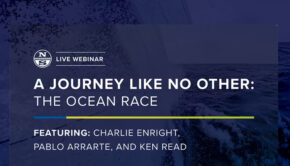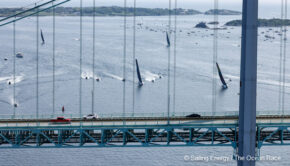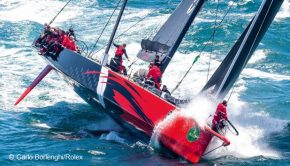Building trust with Comanche
Published on October 22nd, 2014
The size, styling, and purpose of Jim and Kristy Clark’s Verdier Yacht Design & VPLP 100 footer Comanche has turned heads. Here skipper Ken Read provides an update on this record-seeking ocean racer…
The last time I sat down to update all of you Scuttlebutt readers (click here), the entire Comanche team was busting their butts to put the finishing touches on the boat. You could see it in their faces; everyone was exhausted but completely driven to get Comanche on the water.
And they pulled it off. A huge thank you to the entire Comanche shore team, led by Brandon Linton, Tim Hacket, Casey Smith, and to the entire build team at Hodgdon Yachts. To complete a boat of this size in a timeline that allows us to compete in the 70th running of the Rolex Sydney Hobart Race is impressive to say the least. The entire team is now focused on fulfilling Comanche’s goal of first to finish in whatever race she enters, and breaking records whenever the weather cooperates.
While optimistic, we are proceeding with caution. As Jim (Clark) says, “Comanche was not designed simply for the Sydney Hobart, which is an unusual race in many ways. No boat can be designed to dominate in all weather, so we will have a few Achilles heels.” Join us in willing the weather gods to cooperate whenever Comanche leaves the dock.
Comanche went sailing for the first time last week. As you can imagine, taming a 100’ boat is no easy feat. It takes time to get to know the boat, and it’s an ongoing cycle of finding all the weak links, fixing them, and repeat. We are in the process of building trust with our boat and learning the limits of how far we can push.
Our first real test, the 2014 Rolex Sydney to Hobart, is an epically brutal race. We have a few more days of testing in Newport before heading offshore [for the first time] to deliver Comanche to Charleston, South Carolina. There she will be loaded onto a ship for Australia, arriving early December.
Is it enough time? The honest answer is no, we would love to another six months to work the boat in properly. But it is what it is. We knew what we were signing up for.
By now you’ve most likely seen photos of Comanche (click here if not). One of the most frequent questions I’m asked is: “The mast looks like it is placed really far back, what’s the reason?”
Our boat and sail designers used sophisticated modeling capabilities, early in the conceptual phase, to help determine where to place the mast. The team worked closely with naval architects at Verdier Yacht Design, VPLP and JB Braun of North Sails Design Services as they were deciding where to place the mast and appendages. And at the end of the day the mast kept sneaking back…model, test, conclude, try again. We interpreted the position you see today as the most efficient for all-around sailing, especially considering the hull and foil configuration.
I at first didn’t believe having our mast well beyond 50% aft of the bow was efficient, but JB showed us the models and the computers proved us wrong. When it comes to these decisions, you have to trust the experts and their data. That’s what these smart guys get paid for, right?
And the sails? They’re big and require 6-10 men to move them from one place to the other. Because of this, Comanche has a very clean deck that makes it possible to drag the sails in their bags. We have worked hard at storage for the sails both on deck and below. That is why the primary winches are inboard, on their own separate islands, providing space to store at least four of the sails in the cockpit safely.
I also get a lot of questions about the jet black sails and what material they are. It is a new process at North we call 3Di RAW. RAW is a new addition to the North 3Di collection. Originally intended for the Grand Prix circuit, RAW is a stripped down version of traditional 3Di, allowing programs (on average) a 15% weight savings. North Sails did not expect RAW to be a product suitable for offshore sailing, but the technology has proven us wrong. The lightened-up sails are much more durable than expected. In addition to Grand Prix, RAW has found a place amongst offshore teams such as early adopters Spindrift 2. When you think about it, 15% weight savings on record-setting ocean racers will add up quickly.
So that’s what we know, given we’ve only had about a week with Comanche. Definitely more to come. It’s going to be a wild on the mighty Comanche.









 We’ll keep your information safe.
We’ll keep your information safe.